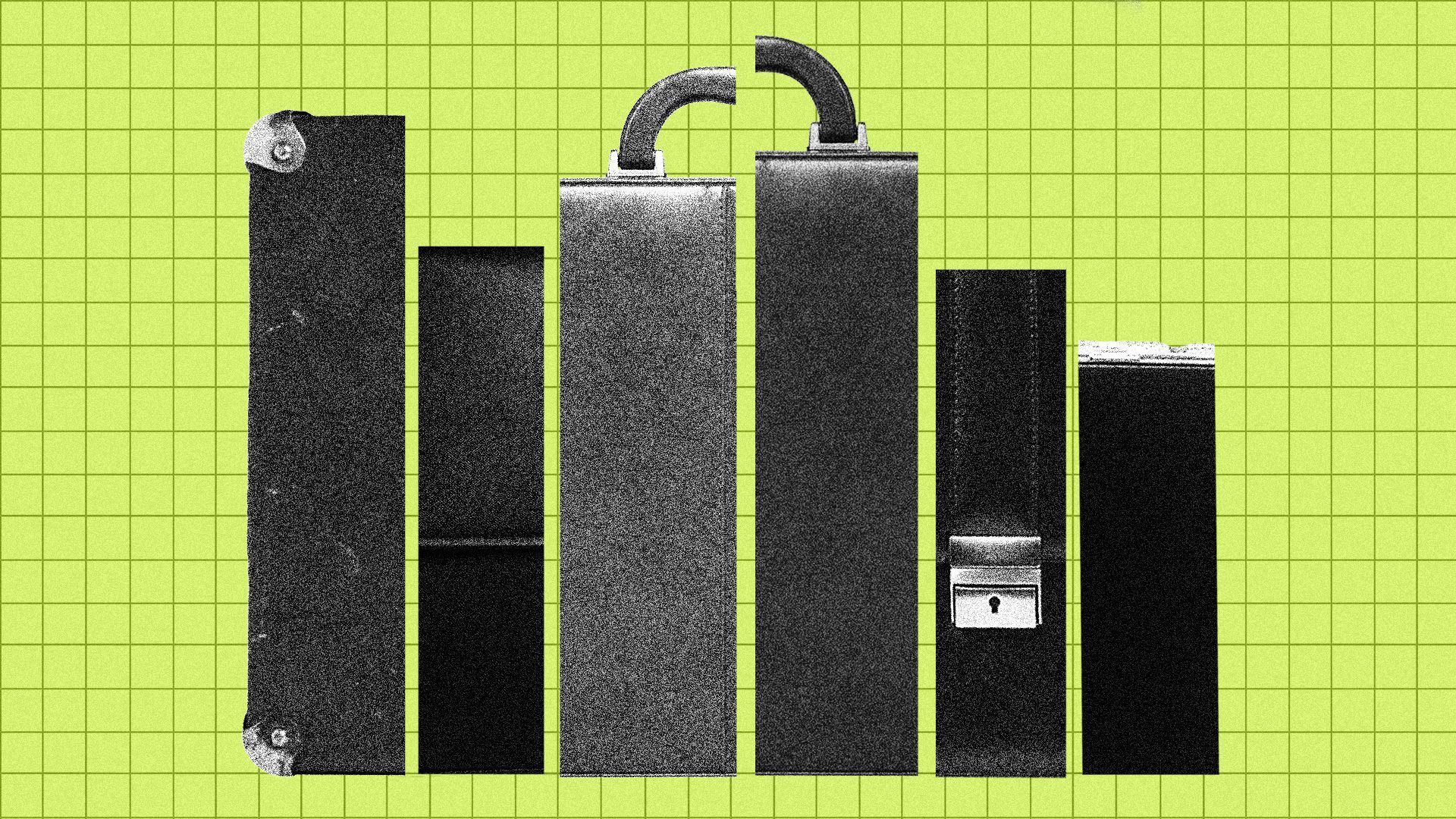October 07, 2021
Situational awareness: After more than a century of R&D, we now have a malaria vaccine. Axios' Bryan Walsh explains why it matters.
- In this week's newsletter: A dive into why Masterworks is worth $1 billion; a cheap new DAF platform; South Dakota's tax-haven status; and much more. All in 1,738 words, a 6.5-minute read.
1 big thing: How Masterworks works
/2021/10/07/1633573211037.gif?w=1920)
Illustration: Eniola Odetunde/Axios
Masterworks is a company that buys paintings and securitizes them, selling off partial ownership to individual investors. It was valued this week at more than $1 billion — which is more than the aggregate value of all the art it has ever bought.
Why it matters: The value of Masterworks itself is growing much more quickly than the value of any of the art it's investing in. As a result, there's a strong case that Scott Lynn, its CEO, has created the most lucrative art-dealing business model of all time.
The big picture: Once Masterworks has acquired a painting, it is normally securitized within a few months. That means the company will have raised back the full cost of buying the artwork, plus a 10% "true-up" payment. Only then, in most cases, will Masterworks actually pay the seller for the work.
- The power of monopsony: Masterworks is now the biggest spender on artworks in the world, expecting to buy nearly $400 million of art this year and closer to $1 billion in 2022. The company has a relatively short list of artists it's interested in, and anybody selling a painting by one of those artists is going to approach Masterworks first.
- As the biggest buyer in the market, Masterworks gets to set its payment terms, especially since sellers want to remain on good terms with a company they're going to want to sell to in the future. That's how Lynn manages to pay for art only after he's already sold it.
What's next: As the Masterworks portfolio grows in value, the company will start to capture an ever-greater proportion of the total value of that portfolio. Like a hedge fund, Masterworks charges 1.5% of assets annually plus 20% of profits, payable when the art is sold. Those charges come on top of the initial 10% premium payable to Masterworks.
The bottom line: While art tends to appreciate slowly if at all, Masterworks has perfected a business model that allows it to flip art at a 10% gross profit every time it buys — and to still retain 20% of the upside on the art, plus a management fee, on the art it has already sold. Lynn says the company is already profitable.
- That would explain its billion-dollar valuation — just so long as the current FOMO/YOLO investing environment sticks around for a few more years.
2. The Masterworks sales pitch

Illustration: Annelise Capossela/Axios
The secret of Masterworks' success is that the art world generally spends very little on marketing.
Masterworks has revolutionized the industry by spending profusely on ads across the internet.
- The pitch: Masterworks sells art as an alternative asset class — a place for investors to find returns that have a low correlation with stocks or bonds.
- Those who expresses an interest in such an investment can then be subjected to a high-pressure sales call from a Masterworks employee — as recounted to Axios by two individuals on the receiving end of such calls. Lynn told Axios that the sales calls are focused on making sure that the investors are suitable, and that his business complies with all Finra regulations.
Paintings are sold as fractional investments that are selling out fast, at which point the opportunity to buy them at the initial offering price will be gone. One prospective investor says they were told that Gerhard Richter was probably a good bet because he won't be alive much longer.
- While there is a secondary market in the shares, it's only available to people who have previously bought investments directly from Masterworks.
Be smart: While Lynn, the CEO, is happy to tell financial journalists that "investing in one of these paintings, you’re never going to earn 10 times your money," his advertising cited made-up returns that can exceed 800 times. (After Axios asked about the claims, Masterworks stopped running those ads.)
By the numbers: Lynn says the average investor puts about $30,000 into Masterworks.
- If people spent that much money buying art directly from artists, it could transform not only many artists' lives but also those of the new collectors, who would discover how wonderful it is to live with art.
- Instead, the money is locked up for between three and 10 years, and the investor will never see the art.
The bottom line: Lynn tells Axios that most of his investors have never heard of most of the artists that they're investing in. "They know who Basquiat is, or KAWS," he says. "They don’t know the other artists. Out of 150,000 investors, very few are art world people."
3. When Vanguard is 13X more expensive

Illustration: Aïda Amer/Axios
Something very rare has just happened in financial markets: A startup called Daffy is challenging Vanguard Group on price. And by a huge margin.
Why it matters: Vanguard Group is renowned for its low fees. It has saved investors billions, not only by charging them very little to manage their money, but also by forcing its competitors to lower their own fees in response. So it's astonishing to see a startup offering a rival product to Vanguard's at a tenth of the cost.
The big picture: Donor-advised funds, or DAFs, hold money that donors have irrevocably pledged to donate to charity, and they generally charge a 0.6% fee — on top of the management fees associated with the funds they invest in.
Driving the news: Daffy invests mostly in Vanguard and other low-cost ETFs. But it takes only a $3 monthly management fee for itself.
- By the numbers: Someone with $500,000 in their DAF would pay $236 in annual fees for managing and investing that money at Daffy. That would compare to a yearly bill of $3,000 at Vanguard, $5,850 at Fidelity, or $7,100 at Schwab.
- The Vanguard fee is particularly striking, since it's more than 10 times the amount that would be paid by an individual parking their own money at Vanguard.
How it works: While most DAFs are marketed at very rich individuals looking to save on taxes, Daffy is aimed at the broad, non-itemizing public (although donations remain fully tax-deductible).
- The concept is that most people have a mental idea of how much they want or ought to give to charity each year. By using Daffy, they can easily commit to giving that much, and separate out that decision from the question of who they want to give to and when.
- Because Daffy charges a flat $3 monthly fee, it has no incentive to hold onto clients' funds, and every incentive to maximize giving.
- It's also mobile-native, very easy to use — and can even be funded from a credit card. Daffy will cover the interchange fee, and allow the full amount to be donated to charity.
The bottom line: Behind Daffy, the non-profit, lies a for-profit startup named Aside that's VC-funded and aims to power many other DAF platforms. Like most startups, it's running at a loss to begin with — which means it's effectively subsidizing Daffy's early adopters.
4. How South Dakota became a global tax haven

Illustration: Sarah Grillo/Axios
South Dakota has become the world's foremost tax haven — right up there with the Cayman Islands, and well ahead of old-fashioned locations like Switzerland.
Why it matters: The hundreds of billions of dollars sequestered in South Dakota trusts are effectively off limits to anybody who might have a legitimate claim on them.
How it works: A South Dakota trust is "the most potent force-field money can buy," in the words of the Guardian's Oliver Bullough.
- Like most tax havens, South Dakota has no income tax, no inheritance tax and no capital gains tax. But the state has gone even further than that. South Dakota allows for extreme secrecy when law enforcement comes knocking, and protects assets from being claimed by creditors, ex-spouses, or pretty much anybody else.
The big picture: Since 2010, almost every country in the world has signed onto the Common Reporting Standard, whereby governments inform each other about assets held by foreigners. The United States is the only major country not to sign on to the CRS, making it much more attractive as a tax haven than places like the Bahamas or Panama.
By the numbers: A decade ago, South Dakotan trust companies held $57 billion in assets. The current figure is about $360 billion — with similar trusts in other states bringing the total for the U.S. close to $1 trillion.
- The United States — not only South Dakota but also rival tax-haven states like Nevada and Delaware — now ranks second only to the Cayman Islands for financial secrecy.
The bottom line: “South Dakota offers the best privacy and asset protection laws in the country, and possibly in the world," tax expert Harvey Bezozi told the Guardian.
5. Europe's energy price shock


The stunning rise in European natural gas and power prices is walloping energy-hungry industries and consumers, Axios' Ben Geman reports.
- There are many causes, including cold weather early this year, the summer heat, and the global economic rebound from COVID-19. All of them drove up demand and left European storage below normal.
Driving the news: Russian President Vladimir Putin said Wednesday more supply is coming, comments that broke the price fever somewhat.
- European policymakers are scrambling to ease the pain, and avoid future shocks, with officials batting around ideas, including a joint strategic gas reserve.
6. Coming up: The September jobs report

Illustration: Shoshana Gordon/Axios
September payroll figures come out Friday morning, Axios’ Hope King writes.
Why it matters: Economists estimate that the U.S. added 500,000 jobs last month, as new reported cases of coronavirus started trending downward and enhanced unemployment benefits expired.
- Meeting or exceeding that projection would mark an upswing from the mere 235,000 jobs added in August, but still a big slowdown from June and July.
- What to watch: Fed Chair Jerome Powell said two weeks ago that “a reasonably good employment report” would make him feel it was time to start tapering.
7. Building of the week: Carnal Hall at Le Rosey

Photo: Christian Richters/View Pictures/Universal Images Group via Getty Images
Le Rosey, a Swiss boarding school, commissioned local architect Bernard Tschumi to build Carnal Hall in 2015.
- The circular structure encompasses over 100,000 square feet and a huge array of uses — concert hall, music conservatory, art studios, learning center, black-box theater, library, offices, guest rooms, and more.
- The materials are steel, on the outside of the exterior dome; concrete, for the base; and a warm wood, for the interiors.